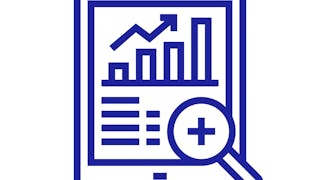This course offers students an opportunity to learn fundamentals of computation required to understand and analyze real world data. The course helps students to work with modern data structures, apply data cleaning and data wrangling operations. The course covers conceptual and practical applications of probability and distribution, cluster analysis, text analysis and time series analysis.



Foundations for Data Analytics Part 1

Instructor: Qurat-ul-Ain Azim
Access provided by EDHEC Business School
Skills you'll gain
Details to know

Add to your LinkedIn profile
14 assignments
July 2025
See how employees at top companies are mastering in-demand skills

There are 7 modules in this course
In this module, we will focus on Python programming fundamentals. The aim is to help you understand Python's basic syntax, data types, and operators, enabling the creation of simple programs. Additionally, we will cover the use of if statements, loops, and proper indentation to control program flow, fostering a foundational understanding of essential control structures in Python programming.
What's included
5 videos6 readings2 assignments1 discussion prompt
In this module we will dive into the diverse landscape of Python data structures, including lists, dictionaries, sets, tuples, and arrays. By exploring real-world use cases, you will uncover the unique strengths and weaknesses of each data structure. You will gain insights into recognizing and understanding the characteristics of these structures, empowering you to make informed choices when tackling programming challenges. Through hands-on practice, you will develop the skills to select and apply the most suitable data structure to efficiently solve a wide range of problems, enhancing their proficiency in Python programming.
What's included
2 videos2 readings1 assignment
In this module we will introduce DataFrames, a pivotal tool in data manipulation and analysis. You will grasp the fundamental concepts of DataFrames, learning how to create, manipulate, and access data efficiently. You will gain essential skills for basic data exploration–including summarizing data, indexing, and slicing, enabling them to extract meaningful insights. Furthermore, this module equips learners with the expertise to clean and preprocess data, covering handling missing values, filtering data, merging/joining datasets, and transforming data for analysis readiness. By the end of this module, you will harness DataFrames for advanced data analysis, mastering group-wise operations, aggregation, and statistical analysis.
What's included
3 videos3 readings2 assignments
This module will equip you with a comprehensive toolkit for proficient data exploration and analysis. It covers the essential techniques and tools for effectively summarizing data sets, encompassing statistical summaries, data visualization, and data cleaning methods. You will learn how to identify and assess missing data, outliers, and anomalies, vital tasks during the initial exploratory phase of data analysis. Furthermore, you will develop the ability to uncover patterns, relationships, and trends within the data using various visualizations, including scatter plots, histograms, and correlation matrices, enabling you to extract valuable insights and make informed decisions from the data.
What's included
2 videos2 readings1 assignment
In this module, we will delve into the fundamental concepts of clustering, a critical component of data analysis and pattern recognition. You will learn to recognize the importance of clustering and its role in identifying meaningful groups within data. You will explore key concepts, including data similarity, distance metrics, and the objective of grouping similar data points together. Additionally, the module equips you with the skills to assess the quality of clustering results through evaluation metrics like silhouette score and Dunn index, as well as visual inspection of clustering plots. By the end of this module, you will be proficient in understanding, applying, and evaluating clustering techniques for effective data analysis and pattern recognition.
What's included
4 videos4 readings2 assignments
This module will provide you with a comprehensive exploration of clustering algorithms, enabling proficiency in this crucial data analysis technique. You will identify various clustering algorithms, such as k-means, hierarchical clustering, and DBSCAN, along with their underlying principles and assumptions. The expertise you will gain will help you determine the most suitable clustering algorithm based on data characteristics and objectives, and you will learn to implement these algorithms using programming languages like Python and tools such as scikit-learn. The clustering quality can be evaluated using internal and external validation methods, as discussed in Week 5.
What's included
4 videos4 readings3 assignments
In this module, you will explore the realm of time series data, gaining a comprehensive understanding of its characteristics, components (trend, seasonality, and noise), and prevalent sources across diverse domains. Through effective visualization techniques and descriptive statistics, you will acquire the skills to recognize patterns and trends within time series data.
What's included
4 videos5 readings3 assignments
Instructor

Offered by
Why people choose Coursera for their career




Explore more from Data Science

Northeastern University

LearnQuest



